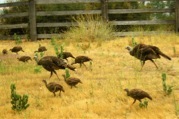Meet a few of the project’s neighbors:

Biological, Cultural, Air & Water Quality, and Other Impacts

Masthead photo:
An example of project grading that stripped natural vegetation and wildlife habitat near the first tee and proposed clubhouse site.
-
 According to the California Department of Fish and Game and the U.S. Fish and Wildlife Service, prior to constructing the golf course the applicants did not:
According to the California Department of Fish and Game and the U.S. Fish and Wildlife Service, prior to constructing the golf course the applicants did not: -
• consult with the US Fish and Wildlife Service (USFWS) on endangered species, as required by the Endangered species Act of 1973;
-
• apply for an incidental take permit for threatened or endangered species;
-
• establish evidence of a satisfactory habitat conservation plan for the species that might be affected – California tiger salamander, vernal pool fairy shrimp, vernal pool tadpole shrimp, and valley elderberry longhorn beetle;
-
• secure a streambed alteration permit from the California Department of Fish & Game (DFG), before cobbling approximately 2.5 miles of streambeds;
-
• consult with DFG regarding state listed or sensitive species or migratory birds;
-
• have a qualified biologist complete a habitat assessment of the project;
-
• submit a preliminary wetland delineation study, as required by Section 404, Clean Water Act;
-
 The Final EIR defers identification and implementation of appropriate mitigation measures until after project approval, and gives responsibility to other agencies. In 2007, DFG specified appropriate mitigations, which were not incorporated into the Final EIR. In September, 2008, they wrote: “The preparers of the RDEIR failed to follow our recommendation, and instead proposed to mitigate the project’s effects by requiring the applicant to ‘consult with the USFWS and DFG.’ Requiring the applicant to consult with resource agencies does not constitute mitigation.”
The Final EIR defers identification and implementation of appropriate mitigation measures until after project approval, and gives responsibility to other agencies. In 2007, DFG specified appropriate mitigations, which were not incorporated into the Final EIR. In September, 2008, they wrote: “The preparers of the RDEIR failed to follow our recommendation, and instead proposed to mitigate the project’s effects by requiring the applicant to ‘consult with the USFWS and DFG.’ Requiring the applicant to consult with resource agencies does not constitute mitigation.” -
 Water Quality: “Golf course run-off is a concern to us as downstream agricultural and municipal water users…” wrote Stockton East Water District’s Kevin Kauffman in May, 2008. “Will this run-off be fully contained? If not, a run-off management plan should be required that includes daily monitoring and monthly reporting to the appropriate Calaveras and San Joaquin County, and the State of California officials to assure Calaveras River water quality is not negatively effected by the golf course operations. Individual home and the clubhouse septic-leach field systems are of equal concern…”
Water Quality: “Golf course run-off is a concern to us as downstream agricultural and municipal water users…” wrote Stockton East Water District’s Kevin Kauffman in May, 2008. “Will this run-off be fully contained? If not, a run-off management plan should be required that includes daily monitoring and monthly reporting to the appropriate Calaveras and San Joaquin County, and the State of California officials to assure Calaveras River water quality is not negatively effected by the golf course operations. Individual home and the clubhouse septic-leach field systems are of equal concern…” -
 Hazards & Hazardous Materials: The golf course fails to provide recommended setbacks between fertilized turf and intermittent and ephemeral streams, riparian areas and wetlands. The original DEIR recommended 50-foot setbacks from such streams during construction activities, yet, as CSERC noted in 2007: “the setback buffering …was not followed during the development of the golf course and the re-contouring and gunniting of the ephemeral drainages.…the ponds are the receiving waters for all the fertilizers, persticides and herbicides that are applied to the turf on the golf course and the sites where the olive trees are growing.” Their concerns were not addressed in the FEIR, in violation of CEQA.
Hazards & Hazardous Materials: The golf course fails to provide recommended setbacks between fertilized turf and intermittent and ephemeral streams, riparian areas and wetlands. The original DEIR recommended 50-foot setbacks from such streams during construction activities, yet, as CSERC noted in 2007: “the setback buffering …was not followed during the development of the golf course and the re-contouring and gunniting of the ephemeral drainages.…the ponds are the receiving waters for all the fertilizers, persticides and herbicides that are applied to the turf on the golf course and the sites where the olive trees are growing.” Their concerns were not addressed in the FEIR, in violation of CEQA. -
 No cultural resource analysis was performed before building the golf course, but cultural resources were damaged or destroyed during its construction, as reported in an April 8, 2006 email from the original EIR consultant to the county: “midden destroyed during road construction”. Unsigned meeting notes from April 25, 2006 refer to “Rock Shelters/Midden - Already damaged - Rd Const/Also Vandalized.”
No cultural resource analysis was performed before building the golf course, but cultural resources were damaged or destroyed during its construction, as reported in an April 8, 2006 email from the original EIR consultant to the county: “midden destroyed during road construction”. Unsigned meeting notes from April 25, 2006 refer to “Rock Shelters/Midden - Already damaged - Rd Const/Also Vandalized.”
When they found evidence of Cultural Resources on site, the applicants did not:
-
• stop work and bring in a qualified professional to determine the importance and appropriate treatment of the find, as required by state law, the National Environmental Policy Act, the National Historic Preservation Act (1966, as amended); or
-
• report archaeologically significant findings to the California Historical Resources Information Center.
-
• Additional damage may have taken place during continuing construction activities after release of the 2007 DEIR.
-
 The DEIR understated the number of oak trees taken, and the FEIR fails to identify the number that would be downed for future construction. The California Oak Foundation is “prepared to challenge the FEIR oak removal findings.” “The project is illegal and therefore can never adequately comply with the California Environmental Quality Act (CEQA).” COF letter 2.12.09
The DEIR understated the number of oak trees taken, and the FEIR fails to identify the number that would be downed for future construction. The California Oak Foundation is “prepared to challenge the FEIR oak removal findings.” “The project is illegal and therefore can never adequately comply with the California Environmental Quality Act (CEQA).” COF letter 2.12.09 -
 All the EIRs failed to evaluate the impacts of greenhouse gas emissions, as required by AB 32. CEQA requires agencies to discuss ways to reduce or avoid these impacts by identifying alternatives or mitigation measures. (Cal. Pub. Res. Code § 21002)
All the EIRs failed to evaluate the impacts of greenhouse gas emissions, as required by AB 32. CEQA requires agencies to discuss ways to reduce or avoid these impacts by identifying alternatives or mitigation measures. (Cal. Pub. Res. Code § 21002)
See also 2.29.09 Air Quality Comments on the RDEIR
-
 The applicants claim Trinitas is a “Wildlife Sanctuary,” yet they promote “Hunting and Fishing” on-site. Which is it? Neighbors attest to sounds of hunting or target practice from the property now. Hunting is incompatible with golfers driving and “bird-watchers” strolling the cart paths/“nature trails” around the private golf resort. It’s incompatible with 13 new private residences the applicants seek to build near a pond on the property. This is just another example of the inconsistency of the proposed uses of the property with the Natural Resources Land Use designation and the Recreational Zoning the applicants are seeking.
The applicants claim Trinitas is a “Wildlife Sanctuary,” yet they promote “Hunting and Fishing” on-site. Which is it? Neighbors attest to sounds of hunting or target practice from the property now. Hunting is incompatible with golfers driving and “bird-watchers” strolling the cart paths/“nature trails” around the private golf resort. It’s incompatible with 13 new private residences the applicants seek to build near a pond on the property. This is just another example of the inconsistency of the proposed uses of the property with the Natural Resources Land Use designation and the Recreational Zoning the applicants are seeking.
The Ridge at Trinitas as proposed is a private membership golf club resort, event facility, 30-room $250-$300 per night overnight lodge, and “luxury” gated home community. A scattering of nesting boxes and grass carp in the ponds does not qualify it as a wildlife sanctuary.






Notable Quotes
“The Service believes that listed species habitat is currently being degraded due to the unauthorized activities resulting in not only a direct loss of habitat, but continuing temporal loss of habitat. Any remediation that is possible on-site to minimize direct and indirect effects of the unauthorized activities should be implemented as soon as feasibly possible.”
USFWS NOP comment letter May 2008
Ground Squirrel
(These tunnel diggers are considered pests around golf courses )
California Whiptail
Jackrabbit
Horned lizard
Wild Turkeys
Bobcat
Copyright 2009 - Keep It Rural Calaveras (KIRC)
Unless otherwise noted, all photographs are the property of KIRC.
Documents were obtained from Calaveras County under the Public Records Act, and from cited news sources.